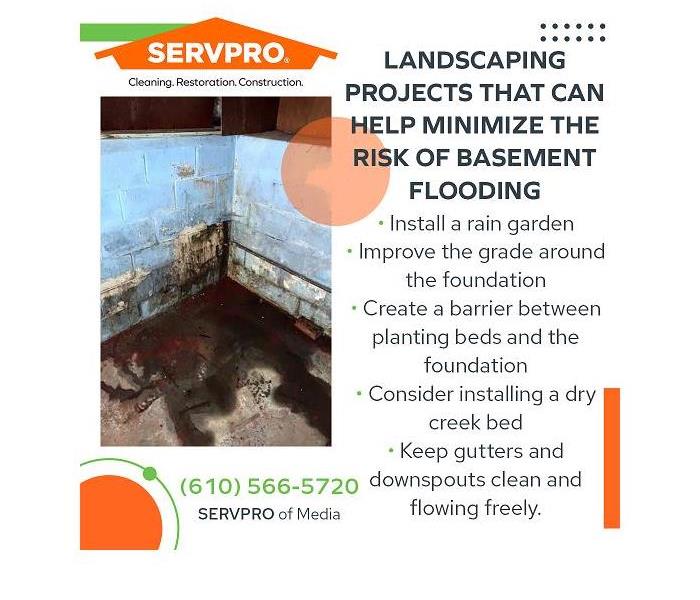Four Landscaping Projects to Reduce the Risk of Basement Flooding in Newtown Square, PA, Homes
9/7/2022 (Permalink)
Blog Summary: SERVPRO of Media explains how landscaping projects can both minimize the risk of basement flooding and make the home more beautiful.
SERVPRO® of Media, PA, provides fire damage, smoke damage, and water damage restoration services. When a homeowner is faced with a flooded basement, these property damage services are indispensable. To help homeowners avoid basement flooding, the professionals at SERVPRO of Media offer the landscaping strategies outlined below.
A dry basement is important for a clean, healthy, and safe environment in the home. A wet, damp basement facilitates the growth of mold and mildew, which can damage anything stored in the basement. The excessive moisture promotes wood rot and rust. Pests such as cockroaches, silverfish, centipedes, and earwigs thrive in the moist environment. During dry spells, ants will crawl into a home in search of moisture and respite from the heat.
Remedies for basement moisture can be very expensive. The installation of a French drain, a sump pump system, and waterproofing are examples. However, less expensive landscaping strategies can be pursued prior to implementing the more costly and invasive solutions. A multi-faceted approach may result in significant cost savings as well as a dry basement.
Below are four landscaping projects that can help minimize the risk of basement flooding.
1. Install a rain garden.
Rain gardens are recessed areas designed to capture excess rainwater from walkways and the lawn. The water is diverted away from the foundation. The bedding soil is comprised of sand, organic matter, and the existing topsoil. This blend enhances proper drainage while inhibiting the accumulation of standing water. The prime location for the garden is away from the foundation between the home and the street. Install low-maintenance plants to control erosion and slow absorption into the ground.
Native plants are an excellent choice for these rain gardens. Hardy, drought-resistant native plants serve as a natural barrier to any street runoff. The extensive root systems of native plants filter contaminated water before it can leach into the groundwater below. Native plants also attract insects that help pollinate surrounding vegetation.
2. Improve the grade around the foundation.
Sometimes, something as simple as adjusting the grade around the foundation of the home solves the basement moisture problem. The grade or slope should be steep enough to drain excessive amounts of water away from the foundation. The recommended slope is one inch per foot, up to ten feet away from the structure. If the grading is close to these specifications, a homeowner can improve the grade where needed with a few wheelbarrow loads of dirt. More extensive grading revisions may require the services of a landscape company with the equipment to haul in more dirt and shape it to the proper grade.
3. Create a barrier between planting beds and the foundation.
If a planting bed is nestled next to the foundation, a shallow gravel barrier can be installed as a break between the mulch in the bed and the foundation. Mulch retains water and moisture that may seep into the basement or crawl space. This gravel landscape feature provides an aesthetically pleasing separation between the mulch and the side of the home. The gravel allows water to drain away from the house.
4. Consider installing a dry creek bed.
On a grander scale, some homeowners create a dry creek bed in the middle of the yard. The large trench is lined with long-lasting, water-permeable landscape fabric and then filled with river rock. The feature is sloped to carry water away from the foundation and the larger area surrounding the home. Discharge from the downspouts can be directed to the dry creek bed. Not only is the prominent feature a beautiful addition to the landscape, but it is also a very effective means to conduct water away from the perimeter of the home.
Some new home construction includes the installation of a French drain. Post-construction installation of this solution is exceedingly expensive. A comprehensive drainage solution may include the installation of a sump pump system in the crawl space or basement.
Bonus Tip: Keep gutters and downspouts clean and flowing freely.
Clean and free-flowing gutters and downspouts effectively capture and transfer large amounts of roof water away from the home. If gutters become clogged and overflow, this water is deposited next to the foundation and may cause basement flooding. If a downspout detaches from the gutter or if a discharge pipe disconnects from the downspout, hundreds of gallons of water will be deposited next to the home with any major downpour. The results could be disastrous. Consider installing one of the gutter guard products that keeps debris from clogging gutters and downspouts.
Inspect gutters, downspouts, and discharge pipes to ensure the entire system is free-flowing and functioning properly. Something as simple as cleaning the gutters, repairing a disconnected downspout, and extending discharge pipes to at least ten feet away from the foundation could eliminate the need to spend thousands of dollars on the installation of a sump pump system or a French drain.
Even the best efforts to control drainage issues can be overwhelmed by severe weather or derailed by a malfunction. In the event of a flooded basement, reach out to the professionals at SERVPRO of Media. Experienced technicians have the training, experience, high-capacity water removal equipment, rapid-spin fans, and industrial-grade dehumidifiers to deal with a flooded basement or other water damage disaster.
For more information about flood damage restoration in Newtown Square, PA, call SERVPRO of Media at (610) 566-5720 or email office@SERVPROmedia.com.






 24/7 Emergency Service
24/7 Emergency Service
